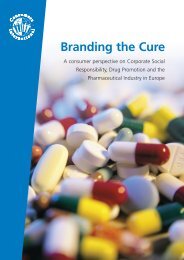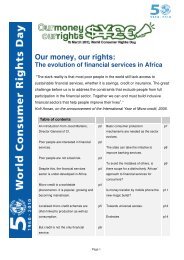Voices for Change: the Consumer Right to Representation
Voices for Change: the Consumer Right to Representation
Voices for Change: the Consumer Right to Representation
You also want an ePaper? Increase the reach of your titles
YUMPU automatically turns print PDFs into web optimized ePapers that Google loves.
World <strong>Consumer</strong> <strong>Right</strong>s Day 2002: <strong>Voices</strong> <strong>for</strong> <strong>Change</strong><br />
Promoting <strong>the</strong> consumer interest can take<br />
many <strong>for</strong>ms. In <strong>Voices</strong> <strong>for</strong> <strong>Change</strong>, we highlight<br />
<strong>for</strong>mal representation be<strong>for</strong>e governments and<br />
o<strong>the</strong>r public bodies, ra<strong>the</strong>r than campaigning<br />
or legal action. A variety of models <strong>for</strong> <strong>for</strong>mal<br />
representation can be found in Chapter 3. But<br />
as Anne-Lore Köhne, a CI Council member<br />
and direc<strong>to</strong>r of Germany’s VZBV, notes, sitting<br />
on a committee is only one instrument of<br />
consultation. “Lobbying and participating in<br />
public and private hearings are just as<br />
important. No single <strong>to</strong>ol is <strong>the</strong> most effective<br />
one – you have <strong>to</strong> use <strong>the</strong>m all. And even <strong>the</strong>n,<br />
sometimes <strong>the</strong> key is running in<strong>to</strong> <strong>the</strong> right<br />
person in <strong>the</strong> right place, minutes be<strong>for</strong>e <strong>the</strong><br />
decision takes place in <strong>the</strong> plenary.”<br />
While <strong>Voices</strong> <strong>for</strong> <strong>Change</strong> focuses on systems and<br />
institutions set up <strong>for</strong> decision-makers <strong>to</strong> hear<br />
<strong>the</strong> consumer voice, many of <strong>the</strong> case studies<br />
received from members in response <strong>to</strong> <strong>the</strong><br />
questionnaire included s<strong>to</strong>ries of legal actions.<br />
The value of legal action should not be<br />
minimised, as it gives teeth <strong>to</strong> demands <strong>for</strong><br />
inclusion by providing access <strong>to</strong> <strong>the</strong> courts,<br />
ei<strong>the</strong>r <strong>to</strong> s<strong>to</strong>p abuses or <strong>to</strong> <strong>for</strong>ce consideration<br />
of consumer welfare and input. Legal action<br />
can take <strong>the</strong> <strong>for</strong>m of manda<strong>to</strong>ry public<br />
hearings, class actions suits, bans on<br />
hazardous products, court action against<br />
pricing policies, suits pressed <strong>for</strong> purposes of<br />
redress and much more. The 1999 World<br />
<strong>Consumer</strong> <strong>Right</strong>s Day publication Where Do<br />
We Stand? includes a section on legal action as<br />
a <strong>for</strong>m of representation.<br />
Taking <strong>the</strong> consumer interest <strong>to</strong> <strong>the</strong> private<br />
sec<strong>to</strong>r is equally important but does not fall<br />
within <strong>the</strong> scope of this publication, as it was<br />
<strong>the</strong> <strong>to</strong>pic of <strong>the</strong> 2001’s WCRD campaign,<br />
Corporate Citizenship in <strong>the</strong> Global Market:<br />
Accountability and <strong>the</strong> <strong>Consumer</strong> Perspective.<br />
<strong>Representation</strong>, not Rhe<strong>to</strong>ric<br />
Effective consumer policy relies on<br />
appropriate regulation, consumer<br />
empowerment through education and<br />
in<strong>for</strong>mation and representation. But true<br />
representation is more than simply involving<br />
consumer experts on panels or public<br />
consultations. It requires permanent channels<br />
<strong>for</strong> input, <strong>the</strong> expectation that consumer views<br />
will be taken in<strong>to</strong> account and <strong>the</strong> recognition<br />
that it is essential <strong>to</strong> good decision-making.<br />
<strong>Voices</strong> <strong>for</strong> <strong>Change</strong> contains many positive<br />
examples of representation. However,<br />
decision-makers may also try <strong>to</strong> use<br />
representation as a public relations exercise<br />
where consumers have no power and<br />
consumer interests are ignored. Many of <strong>the</strong><br />
case studies in Annex B show how consumer<br />
organisations have dealt with this, as in <strong>the</strong><br />
following example from Brazil.<br />
Brazil: Lost <strong>the</strong> battle, won <strong>the</strong> war<br />
The Institu<strong>to</strong> Brasileiro de Defesa do<br />
Consumidor (IDEC) played a crucial role<br />
in getting 132 dubious antibiotic mixtures<br />
taken off <strong>the</strong> market – although it was<br />
expelled from <strong>the</strong> Technical Advisory<br />
Commission on Medical Affairs <strong>for</strong> doing so.<br />
The Commission, on which IDEC<br />
represented consumers, was at pains <strong>to</strong><br />
keep in<strong>for</strong>mation about <strong>the</strong>se drugs secret<br />
from consumers, but IDEC went public<br />
with doubts about <strong>the</strong>ir efficacy. As a result,<br />
it was thrown off <strong>the</strong> Commission in 1996.<br />
But in 1997, <strong>the</strong> federal government turned<br />
around and banned <strong>the</strong> sale of <strong>the</strong> drugs<br />
in question.<br />
Real representation is also inclusive. A basic<br />
challenge <strong>for</strong> those charged with representing<br />
consumers is <strong>to</strong> constantly be aware of who<br />
<strong>the</strong>y are representing and why. <strong>Representation</strong><br />
must be based on research as well as proactive<br />
measures <strong>to</strong> seek out <strong>the</strong> views of <strong>the</strong> people<br />
who would o<strong>the</strong>rwise not be heard. <strong>Consumer</strong><br />
representatives must consider this through<br />
consultation and dialogue with <strong>the</strong>ir<br />
constituency, as outlined in Chapter 4.<br />
But constituencies are no longer local.<br />
Increasingly, representation needs <strong>to</strong> encompass<br />
regional and global issues and be aimed at<br />
international institutions. This is now being<br />
recognised by institutions <strong>the</strong>mselves. The<br />
European Union has recently undertaken <strong>to</strong><br />
improve consumer representation within its<br />
policy-making. The Co<strong>to</strong>nou Agreement<br />
9






![pkef]Qmf eg]sf] s] xf] < - Consumers International](https://img.yumpu.com/6479658/1/184x260/pkefqmf-egsf-s-xf-consumers-international.jpg?quality=85)
